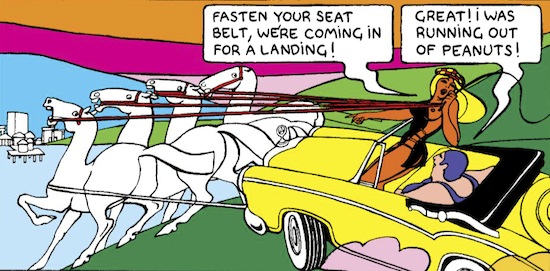It’s been a while, comics fans! I’ll be taking over the intro just for this month as Mat’s been off doing awesome stuff with Teeth Of The Sea (touring Europe, performing with Wire in London). If you don’t know TOTS, seriously, check ’em out, they’re a considerable cosmic force.
I went to Vegas last month to see Def Leppard perform all of Hysteria. When they launched into ‘Women’, I remembered that the video for this ’87 single featured a
‘Def Leppard And The Women Of Doom!’ comic, though except for the pages onscreen, the comic itself was never actually made. A shame, as you’d think it would’ve been a cool thing for fans to have – the panels in the video look fun, with references to Mötley Crüe and James Bond – especially considering Def Lep’s monstrous success at the time. When I returned home, I came across my KISS comic from ’77 (“Printed in real KISS blood”) that I got for xmas at the height of my KISS fanaticism in ’88. After a few summers back spent engrossed in Robert Anton Wilson and Grant Morrison’s The Invisibles, I’m never one to pass up fun with numbers and coincidences and following on from those 8s and 7s, the 6s soon came my way in form of The Adventures of Jodelle, first released in 1966 and heavily imbued with the spirit of rock n’ roll. I can’t say enough great things about Jodelle but I’ll leave that until the review below. It should be noted that said KISS comic features Dr. Doom, whose Box Of Khyscz contains the band’s secret superstar personalities. As far as I know, excellent as it would be, the band Doom have never made a comic where they battle KISS or Def Leppard.
As for 5s and 4s, let’s not forget that Free Comic Book Day is May 4th this year. Now let’s get to the reviews! 3…2…1…
Guy Peellaert – The Adventures Of Jodelle
(pub. Fantagraphics)
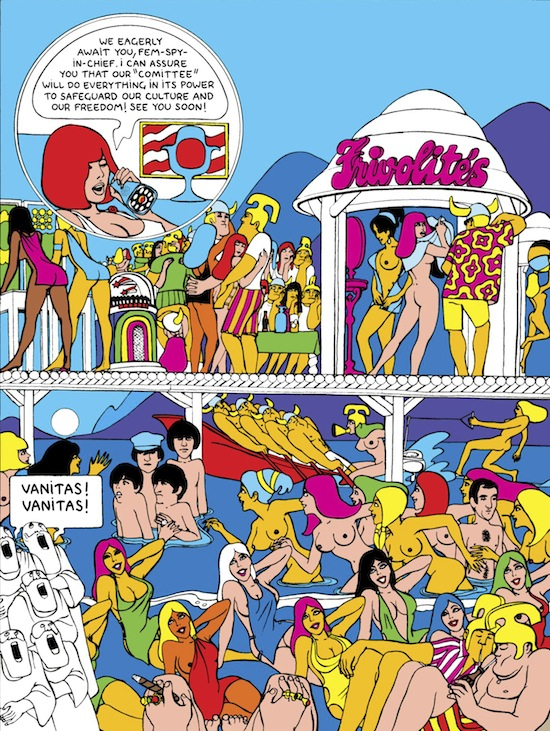
The original Pop Art comic and one of the first ‘adult comics’ (released a year after Barbarella by same publisher Eric Losfeld), Jodelle is an artistic tour de force. Peellaert’s powerful and playful imagination is given free reign in bold flat colours and striking black lines as he transports 60’s American excess and consumerism to the Roman empire, 14 A.D. The fierce Proconsuless and her armies are attempting to seize power from the guitar-playing Emperor Augustus. Scantily clad Fem-Spies abound, working with or battling against ether-powered Aunties who produce pulverizing spit, muscular Glamurians who must watch out for the melty water, and a young vampire druid, amongst a host of others. At the centre of it all is Jodelle, a red-haired superspy modeled on yé-yé star Sylvie Vartan, who in her mission to bring down the Proconsuless escapes with vital information but contracts amnesia and is sold into slavery.
Jodelle is fantastic in every sense of the word, filled with in-jokes and time-defying references, nudity and sex (not always coinciding), exaggerated violence, but most importantly a sense of pushing the edges of possibility. And the oversized volume it comes in is extraordinarily well done. Eighty-six pages of extra essays and biographical information accompanied by hundreds of photos and panels of Peellaert’s post-Jodelle projects. Never one to be pigeonholed, his art sought the appropriate mediums for many individualistic and forward-thinking productions. He would go on to work in television, theatre, photography, and film, collaborating with The Bee Gees and Serge Gainsbourg, designing the album covers for Bowie At The Beeb, Diamond Dogs, The Rolling Stones’It’s Only Rock’n Roll, and producing Rock Dreams with Nik Cohn, soon leaving comics behind all together.
Later this year Fantagraphics are due to release Peellaert’s follow-up to Jodelle, Pravda. This time the heroine looks like Françoise Hardy and, from what’s shown of the story here, reminding me of Jerry Cornelius, wearing only leather vest, belt and boots, roaming the world on a vehicle that’s half-motorcycle, half-black panther. Enjoying Jodelle as much as I did, I can’t wait for the release of Pravda. Aug Stone
Paul Levitz – The Golden Age of DC Comics 1935-1956
(pub. TASCHEN)
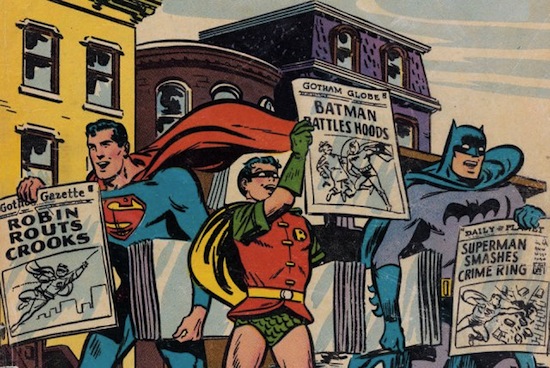
TM & © DC Comics. All rights reserved.
World’s Finest Comics No. 63. Cover art detail, Win Mortimer, March–April 1953.
As is their wont, TASCHEN Books has put out a gorgeous oversized 416 page collection of covers, panels, and memorabilia from the Golden Age of DC. Along with a Joe Kubert interview and 40-page history of the company from its earliest days, the captions of each of these many items provide a fascinating account of the birth of the superheroes and America’s relationship with comics from their beginnings through World War II and into the clean-up operations of the 1950’s.
One can spend hours going over the curios in this wonderful book. Besides a lengthy section on vintage Superman, of course, we also see some of Jerry Siegel’s other projects – The Star-Spangled Kid and Robotman – as well as earlier collaborations with Joe Shuster such as Spy, the intriguing Dr. Occult, Ghost Detective and Dr. Mystic, the Occult Detective, and the ‘dry run for Superman’, Slam Bradley. Heavy also on Wonder Woman and Batman (some nice old Two-Face and Joker covers), including my favourite pic of the book – a 1940 Brazilian ‘O Lobinho’ magazine cover showing a shirtless and tightsless (just cape, mask, and Speedo) Batman hoisting a villain above his head with a note explaining ‘the details of his costume were…not yet familiar’. Other odd highlights are ‘Captain Marvel in the Land of Surrealism’ and Flash Comics No. 91 with Hawkman and Hawkgirl on the cover for the story ‘The Phantom Menace’.
Sections are dedicated to such luminaries as Joe Simon & Jack Kirby, Sheldon Mayer, Jack Cole (the inventiveness, humour, and compositional style of his Plastic Man had me picking up DC’s Archives Volume 1 first chance I got), Will Eisner (reprinted in full is Eisner’s personal favourite, the poignant and sad ‘The Story of Gerhard Shnobble’), and Harvey Kurtzman with the beginnings of MAD Magazine. We also see covers of Romance, Western, Horror, Fantasy, Space Adventure and movie tie-in comics; lines that, in the case of the first few, proved as popular as the superheroes while other titles vanished after only a handful of issues. Aug Stone
Alejandro Jodorowsky and O.G. Boiscommun – Pietrolino
(pub. Humanoids)
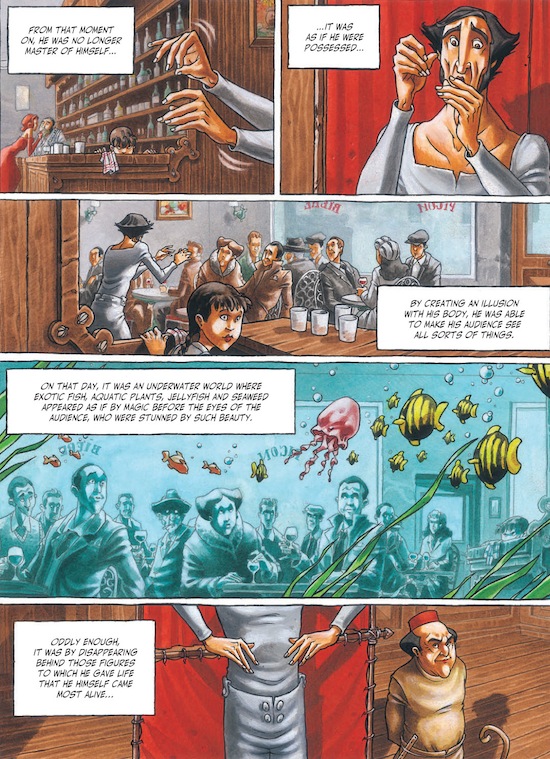
Big fan that I am of Jodorowsky’s work, perhaps my surprise that he had written ‘mimodramas’ for Marcel Marceau was unfounded, given how far-reaching his artistic endeavors have always spanned. The two worked together when Jodorowsky moved to Paris from Chile in the 50’s and the touching dedication to this book tells that Marceau inspired the story and was looking forward to seeing it.
Both heart warming and breaking, Pietrolino is the tale of a street performer whose signature act lands him in a Nazi work camp with broken hands, the very tools he uses to bring much-needed hope and joy to the crowds of occupied France. As if this isn’t enough, his love abandons him for the very barkeep who ratted him out, the aptly named Pantalone. Pietrolino’s romantic fortunes don’t improve much over the course of the book – and we feel for him in these various despairs – but he is given a great gift after fame finally comes his way through the laughter he brings to the world.
Boiscommun’s artwork is excellent, conveying rich emotional nuance from full city scene to facial close-up. An important theme for Jodorowsky is artistic redemption and this is shown wonderfully throughout the book, in the very way the tale is told, filled with all the variety that makes up life, and building to a glorious climax. Aug Stone
Gabriella Giandelli – Interiorae
(pub. Fantagraphics)
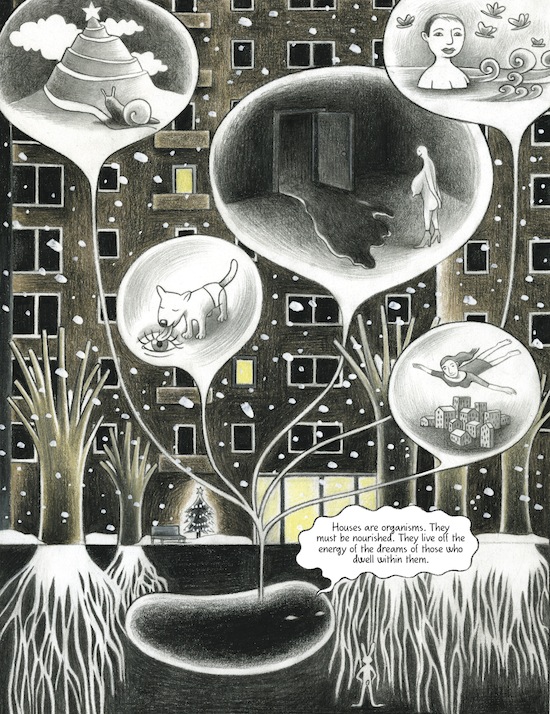
A beautiful book, a beautiful story. We are shown the life of an apartment building over two days in December, guided through its interior and viewing the lives of its residents by means of a white rabbit, invisible to most of its inhabitants, moving through its walls.
Giandelli deftly details the sweetness of falling in and the bitterness of falling out of love at this time of year, as well as the gradations in between. These characters are given great life in such short space via little idiosyncrasies and small unseen acts. Our rabbit guide reports to a giant black blob living in the basement, who feeds on the tenants’ dreams and holds onto their nightmares for them so they may be at peace. Dreams are both spoken of and shown with poetic vision.
Amidst the amorous and heartbroken, an old woman, Angela, dreams of a great mushroom and realizes why she hasn’t died yet. Enlisting the help of a young junkie who spends most of his time hanging out in the basement, Angela and her carer, Irina, devise a plan to accomplish what she needs to do. This culminates in a fantastic psychedelic dreamscape based on Algonquin religious beliefs, in which The Great Rabbit plays a part. Interiorae is a lovely glimpse into the lives of disparate characters, linked in a space beyond their dreams, whose lives tangentially touch and then pass on. Aug Stone
S. J. Harris – Eustace
(pub. Jonathan Cape)
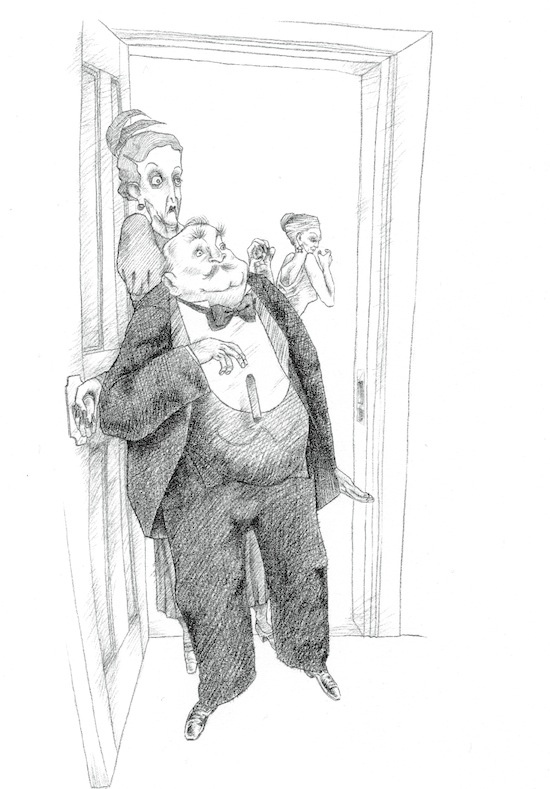
Eustace is a sick little boy. So ill is he, that it would sicken one to look at him in panel after nauseating panel. And this is what Harris aims far, leaving decor and backdrop to a minimum and forcing you to focus on, more than anything else, the palsied, trembling head of Eustace, the boy Proust, pencilled out in Harris’s quivering lines.
Practically abandoned by both parents, the confirmed invalid must raise himself, when he can barely raise himself out of bed. Tortured by a stream of slobbering aunts, he is a bearable figure of impotent rancour, crushed by relatives, the indoors, and unnamed illness. For most of the story, we are trapped with him in the sadly Edwardian interior of his room, listening to him mumble to his ‘imaginary strangers’, amongst whom, presumably, we number. Like its protagonist, the story continually threatens to go nowhere, until the dangerous Uncle Lucy pops out from under the bed and everything gets worse.
Combining the arch style of Edward Gorey’s nomenclature with the uneasy, ailing air of Salad Fingers, it is all too sickly to be fun, but it is ensnaring. The line is drawn (and drawn with shaky hand at that) between a sick body and the body’s sick pleasures, as a dying boy explores his own sexuality in the dark recesses of his mind, where only ominous wordplay and surreal tangents offer a reprieve. When Eustace receives a visit from Uncle Lucy, he will never recover; but he was sick and he wasn’t going to recover anyway. Reggie Chamberlain-King
Mal Coney, Stephen Downey, on an idea by Robert Curley – Noe the Savage Boy
(pub. Atomic Diner)
Over the last ten years, the most notable rise in Irish comics was that of Dublin’s Atomic Diner, which, through the Gaelic vampire saga, Roisin Dubh, has managed to gain notoriety in only its few years of operation. Everything released by the press is percolated first through the mind of owner and comic book shopkeeper, Robert Curley. His bubbling beaker of ideas is parsed off to script writers and artists and there they become actual fact. Through this process, and whether or not by design, Curley seems to have reverse-engineered a lost Golden Age of Hiberno-adventure and genre comics. Titles include: Black Scorpion, Jennifer Wilde, The Crimson Blade, and The League of Volunteers (the last word more threatening in Ireland than most other English-speaking countries). They are all strictly Irish heroes, whose stories unfold across the table of Irish history.
The latest, Noe the Savage Boy, is a piratical fantasy of the type not seen in any recent issue of Boys’ Own Adventure. Scripted by Mal Coney and drawn by Stephen Downey (both Belfast men), the first issue gives very little away: a manchild is stolen away on the high seas. If we’re lucky, this fella will turn out to be the titular Savage Boy and then all Hell will break loose.
Text and image both achieve an old-time authenticity, whether they like it or not, and Downey’s figureheads and sterns point out from the page majestically. Were the cover not so glossy, you could believe you were reading a vintage piece of stuff, so committed are they to swashbuckling as it used to be represented.
Full disclosure: Robert Curley wrote plenty of scripts for Atomic Diner until he had too many ideas. Reggie Chamberlain-King

